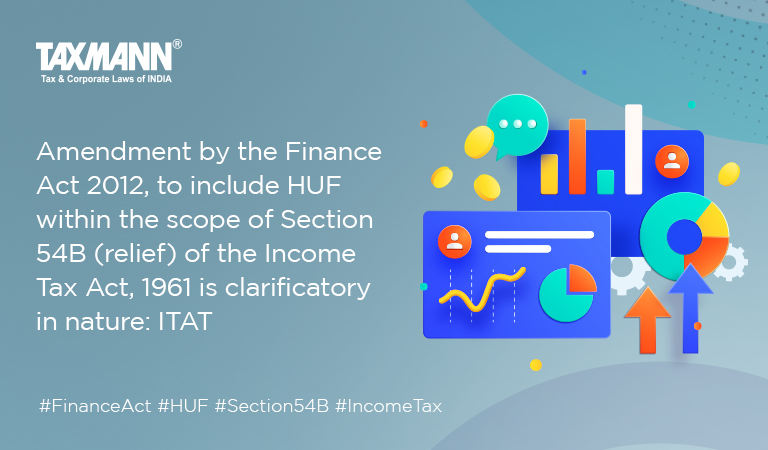Amendment by the Finance Act 2012, to include HUF within the scope of Section 54B (relief) of the Income Tax Act, 1961 is clarificatory in nature: ITAT
- Blog|News|Income Tax|
- 2 Min Read
- By Taxmann
- |
- Last Updated on 15 July, 2021
Case details: Shri Sitaram Pahariya (HUF) v. ITO – [2021] 127 taxmann.com 618 (Agra - Trib.)
Judiciary and Counsel Details
-
- Laliet Kumar | Judicial Member & Dr. Mitha Lal Meena | Accountant Member
- Sunil Bajpai | CIT-DRfor the Respondent
Facts of the Case
Assessee, being a Hindu Undivided Family (HUF), filed its return of income declaring nil income. However, during assessment proceedings, Assessing Officer (AO) noted that assessee had declared nil income under the head capital gains on the sale of the property. Accordingly, AO denied exemption claimed by assessee under Section 54B and Section 54F and made additions to assessee’s income.
With respect to section 54B, AO held that deduction is not admissible for Assessment Year 2012-13 in the case of a HUF. The benefit was available only with effect from Assessment Year 2013-14 when the amendment was brought by the Finance Act, 2012.
On appeal, CIT(A) appeal granted exemption claimed under section 54F. However, upheld the disallowance of section 54B exemption. Aggrieved-assessee filed the instant appeal before the Tribunal.
ITAT Held
The Tribunal held that the bare reading of section 54B, prior to amendment, make it abundantly clear that the benefit of section 54B was available to ‘assessee or parents of his’. Assessee has been defined in section 2(7) means every person in respect of whom any proceeding under this Act has been taken for the assessment of his income. The person has been defined under section 2(31) which includes an individual, Hindu Undivided family, etc.
The conjoined reading of the above-said provisions makes it abundantly clear that an individual, Hindu undivided family, etc. is assessee for the purposes of the Income-tax Act. As the HUF can be an assessee, the assessee used in section 54B, can be interpreted to mean, even HUF besides being an individual, etc.
There were contrary views of various courts with regards to the allowability of section 54B deduction in case of person other than individuals. Thus, the controversy had been put to rest by the subsequent by the Finance Act 2012.
Therefore, the amendment brought on by the Finance Act 2012, in section 54B by replacing words ‘assessee or a parents of his’ with “the assessee being an individual or his parent, or a Hindu undivided family” was classificatory in nature and assessee would be eligible for deduction for Assessment Year 2012-13 as well.
Disclaimer: The content/information published on the website is only for general information of the user and shall not be construed as legal advice. While the Taxmann has exercised reasonable efforts to ensure the veracity of information/content published, Taxmann shall be under no liability in any manner whatsoever for incorrect information, if any.

Taxmann Publications has a dedicated in-house Research & Editorial Team. This team consists of a team of Chartered Accountants, Company Secretaries, and Lawyers. This team works under the guidance and supervision of editor-in-chief Mr Rakesh Bhargava.
The Research and Editorial Team is responsible for developing reliable and accurate content for the readers. The team follows the six-sigma approach to achieve the benchmark of zero error in its publications and research platforms. The team ensures that the following publication guidelines are thoroughly followed while developing the content:
- The statutory material is obtained only from the authorized and reliable sources
- All the latest developments in the judicial and legislative fields are covered
- Prepare the analytical write-ups on current, controversial, and important issues to help the readers to understand the concept and its implications
- Every content published by Taxmann is complete, accurate and lucid
- All evidence-based statements are supported with proper reference to Section, Circular No., Notification No. or citations
- The golden rules of grammar, style and consistency are thoroughly followed
- Font and size that’s easy to read and remain consistent across all imprint and digital publications are applied








 CA | CS | CMA
CA | CS | CMA


